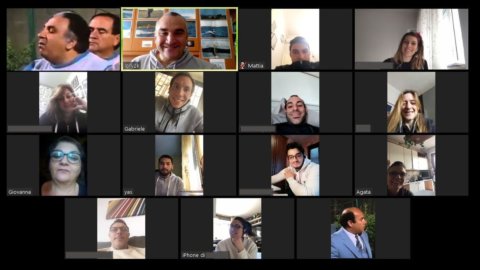Teleworking, smart working, remote work, remote lessons: these are all terms that entered the collective lexicon as soon as the coronavirus pandemic started, which forced the world to find quick and effective alternatives in order to stay connected and work even during the quarantine.
Fortunately, the basic infrastructure, the Internet, was already sufficiently developed. Even the apps or programs usually used by teenagers and geeks to make calls and video calls have had a sudden technological acceleration. Millions of people, every day, now use a technology that until recently was considered little more than a gadget.
Let's see which are the best apps or programs for calling and video calling, making the necessary distinctions according to use.
A few rules for a good videoconference
The fluidity of a video call depends on numerous factors that combine: connection speed, number of participants, efficiency of the hardware used and type of peripheral used. Simplifying a lot, the best combination to have the best possible videoconference it is to use a PC that is not old, therefore with a fast processor, to be connected with a minimum bandwidth of 20 MB in download using a fast Wifi or a LAN. So if you use a mobile phone that is not exactly recent using a slow connection it is probable that the video and audio will not be very fluid.
Also be careful to use laptops, tablets and mobile phones using only the battery of the device. In this case, energy saving systems often come into operation which, in order to increase autonomy, reduce the performance of the device itself, penalizing the fluidity of the call.
During a video call it is good to adopt some sort of code of good manners, with particular care especially in professional or school chats. First of all, when one of the conference participants speaks, it is good practice for all the others connected to at least temporarily deactivate their microphone. This prevents background noises, or perhaps some inappropriate phrases, from causing great confusion.
If it is not necessary, it is strongly recommended to also deactivate the video when listening only. This reduces the bandwidth to be used and in multiple chats of more than 10 people the best efficiency in using the network ensures smoother and more responsive video conferencing.
During a school or work video call, remember the context in which you are framed. The background must be appropriate and one's personal appearance cannot obviously be dismissed.
Some apps allow you to share your screen to encourage the exchange of ideas about files and images and even here you need to be very careful about what you are viewing before sharing. It seems obvious, yet there are very many cases of sharing images or embarrassing texts, which perhaps are placed in the background or appear in the names of the windows that are shared.
From a technical point of view, the use of a headset, perhaps with a microphone, is preferable to using the speakers and microphone of the PC or mobile phone. Indeed, they often create a annoying echo effect due to sound from the speakers returning to the microphone.
Also pay attention to the attitude adopted during a video call. Of course, you don't need to be filmed while you are distracted by something else, such as typing on the keyboard or consulting your mobile phone. The rule is to be always ready to answer questions and requests for assistance.
Apps and programs
It is certainly the most famous and widespread APP on all mobile phones in the world and is therefore the simplest way to hold an online meeting. However, WhatsApp has two major limitations: the first limits the maximum group of participants to less than 10 people (the increase to 8 people was recently announced). For this reason it is not used in scholastic or professional fields.
Furthermore, the App is only available on mobile phones, so video calls cannot be made from a PC, which limits its use to small groups. There is the possibility of using WhatsApp from the web, but only for some functions and not for calls. However, it is a very convenient way to make text chats and share files.
Microsoft Teams
It is a cross-platform application (that can be loaded onto a PC, mobile phone or tablet) which has had a very rapid development and diffusion during the coronavirus, especially in the working and professional fields. During the pandemic Microsoft has granted for free use of the App for everyone. However, there are considerable discounts for schools and professionals even in the "normal" version.
It is currently one of the flagship products even if not very "playful" and therefore not suitable for laughing chats between friends. It offers chats and video calls between two or more groups of people, a cloud space for the group that is using it of several GB to store the files a team works on. Being a Microsoft product it is integrated with Office for collaborative work using Word, Excel, etc.
Zoom
Specialized newspapers and users have voted Zoom several times as the best application for making online meetings. It was the favorite app, at least at the beginning, of schools that had to set up, in a hurry, a videoconferencing system with their students to try to start the distance teaching. It is a multi-platform app that has the advantage of being able to be used only from a browser, thus minimizing any installation difficulties. Participants will receive a link to open with their browser to start the video conference. Zoom has also opened its platform to facilitations during the pandemic, removing the time limits on the free version.
Skype or Whatsapp
Another very famous and historic App, it had fallen into neglect before the Coronavirus, but has recently regained popularity. It accepts very large groups (up to 50) and is cross-platform (it can also be used from a browser). You can share files and screen to allow everyone to view and discuss documents or files, plus use numerous features available.
Several functions were added just during the pandemic emergency to make it more captivating. You can record the entire video call so that you can repeat it to those who were absent, use the automatic transcription of the video as subtitles, change the background or fade it out.
Google Suite
Google offers numerous programs to share video, audio and work, during the pandemic Big G has extended the functions of its apps to users of other programs as well. Hangouts is the historic video conferencing application, used in theory by anyone with a Gmail account and by companies using G Suite. It can be used, by invitation, even by people who don't have a Gmail account. The APP is can also be used from an internet browser and allows screen sharing (from PC).
The program accepts up to 25 users although there is a special version called Hangouts Meet specifically made for meetings. Since you can activate the chat without installing anything, just distribute a meeting link. Some options are active for everyone during the Coronavirus emergency. Worth mentioning is the expansion of meetings to 250 people and a very useful live streaming function for 100 spectators. Basically there are the functions of video conferencing with a video transmission. Furthermore, being Google products, you can take advantage of its Google Drive cloud for record meetings or save videos.
Although technically a chat app, Instagram is above all known for its "playful" features of inserting filters and deformations on the video. Preferred for this by young people, Instagram however has a maximum limit of 4 participants and can only be used from mobile devices.
HouseParty
Absolutely "young" app that allows you to make calls with up to 8 people. These will be displayed all on the same screen, which is more unique than rare. The novelty is that it is possible to launch games to play with the participants in the call.





